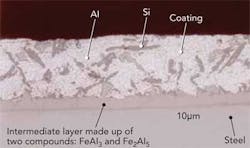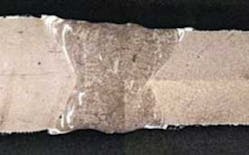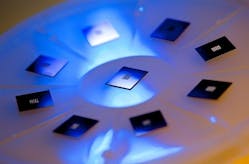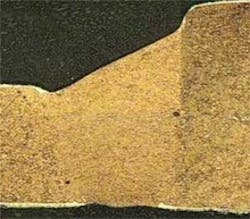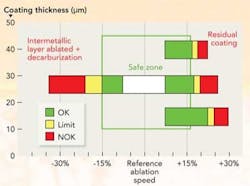R. Vierstraete, W. Ehling, F. Pinard, L. Cretteur, A. Pic, and Q. Yin
LASER ABLATION HAS PROVEN TO BE AN EFFICIENT AND RELIABLE PROCESS TO PREPARE EDGES ON AL-SI COATED PHS
For the last few years, the use of hot stamping and Press-Hardened Steels (PHS) for the body-in-white (BIW) structure has been booming. PHS (commonly based on boron steels) successfully produces Ultra High Strength Steel with easy formability by hot stamping and quenching effect during cooling in the press. Due to crash regulations and weight reduction strengthening, this trend will be seen in many new vehicles produced worldwide in the coming years.
One of the specifics of ArcelorMittal coated PHS is its aluminum-silicon based coating (Al-Si trademarked Alusi), which is high temperature resistant, prevents excessive oxidation of the part during hot-stamping, and ensures good corrosion resistance for the finished part.
FIGURE 1. Surface of uncoated PHS after thermal treatment.
Al-Si coated PHS-based laser-welded blanks (LWB) are an innovative solution for crash management and weight reduction, as they combine the advantages of both hot-stamped steel and tailored blanks technology:
- Ultra High Strength Usibor 1500P, gives excellent anti-intrusion properties at a moderate weight (Al-Si coated steel showing an ultra high strength but limited elongation)
- Excellent energy absorption of the Ductibor 500P (combination of high strength and higher elongation)
- Laser blank welding allows the user to select the position and thickness of each sub-blank to optimize the weight and behavior of the final part.
Targets for LWB parts are mainly safety parts involved in the crash behavior of the car: B-pillars, rails (front and rear), and door ring.
Laser butt welding of Al-Si coated PHS
Laser welding of coated PHS like Usibor 1500P and Ductibor 500P—which are both aluminum-silicon (Al-Si) coated products—requires specific care to reach optimum performance. With a standard laser welding process serious dilution occurs in the molten zone leading to a creation of FeAl intermetallic phases and modification of cooling diagrams in the area that produce ferrite, both visible as white areas in the fusion zone. As a result the in-use properties of the LWB can be strongly reduced. During tensile impact tests on the weld, the failure can occur along these white areas (see FIGURES 3 and 4).
However, by completely removing the Al-Si coating—in order to avoid the creation of intermetallic phases during laser welding—the corrosion resistance will be heavily diminished (Fig. 1) due to oxide layers which are created during the heat treatment before hot stamping. These layers are not adherent and could lead to poor paint adhesion.
Laser ablation
In this context, a new approach was developed and patented by ArcelorMittal to produce high functionality LWB in Al-Si coated PHS, so that after hot-forming the part is fully functional. It fulfills all customer specifications such as minimum strength and elongation in the various areas, high energy absorption capabilities, no failure in the weld and corrosion performances.
FIGURE 5. Enhanced weld seam characteristics with ablated LWB.
The new approach is to perform edge preparation to partially remove the Al-Si coating, removing enough coating to produce a safe weld but leaving enough coating to retain good corrosion performances.
FIGURE 2. Detail of Al-Si coating before heat treatment.
To reach this goal, various removal processes were tested. In the end, a laser ablation process was selected as the only one that reaches the product specifications with the ability to be fully controllable for quality assurance management.
Coating structure
The Al-Si coating (Fig. 2) has a nominal thickness of 30µm (slightly vary due to the hot dip aluminizing process) and has a basic composition of 90%Al + 10%Si with local Si enrichment. The intermediate layer at the interface with the steel substrate has a thickness of 5–10µm and has a basic composition of FeAl3 and Fe2Al5.
While the Al-Si coating has a fusion temperature of 650–700°C, the FeAl3 and Fe2Al5 compounds of the intermediate layer have a higher fusion temperature of 00–1100°C. The intermediate layer also has a higher hardness than the Al-Si coating.
Selection of ablation laser device and parameters
Ablation is defined as the removal of material from the surface of an object by vaporization, chipping, or other erosive processes. Laser ablation is a common process in applications such as laser marking, laser cleaning and control processes such as Laser Induced Breakdown Spectroscopy (LIBS). The parameters with significant influence on the ablation process are wavelength, pulse duration, pulse energy, and energy density.
Laser ablation was selected as the de-coating process for Al-Si coated PHS, because other coating removal processes, especially mechanical ones, are unsuited for removing the free Al-Si layer while keeping the thin intermediate layer. Additionally because of the high energy density of a focused laser beam, the higher fusion point of the intermediate layer compared to the free Al-Si layer offers a certain process window for laser ablation.
However, the right ablation process parameters have to be defined. While ultra short laser pulses (fs, ps) have very high energy material removal efficiency due to negligible heat conduction in the material, their average output power is limited, as well as the de-coated surface efficiency. Q-switch lasers with pulse duration in the ns-area have lower energy material removal efficiency due to some heat conduction in the material but offer higher output power rates. The material is partly removed mechanically by laser induced shockwaves (spallation) and also partly by fusion and vaporization.
This is useful in this application: as the ablation laser moves continuously over the seam edge and removes the Al-Si layer, while the intermediate layer acts as a barrier (higher hardness than the Al-Si layer) with a higher fusion temperature. At points where the coating is thinner than the nominal value, the extra energy input on the intermediate layer will, to a certain point, not destroy it but only heat it up.
Laser ablation test results
The idea for laser ablation of Al-Si coating occurred in 2004. At that time, it was a proven technical solution but not feasible due to lack of power of the laser sources. Various conventional techniques (not laser based) have been tested, but none reached the technical target. However, evolution of the laser sources made it possible to reconsider a laser based solution for the coating removal. We went back to laser, and first successful trials were realized in 2006.
FIGURE 6. Crash test on Al-Si-coated PHS Usibor/Ductibor ablated LWB safe weld seam.
FIGURE 7 shows a blank that is ablated top and bottom face of the edge. It is clearly visible that laser ablation has completely removed the Al-Si layer; the intermediate layer remains entirely.
In 2007, for larger development and prototype mass manufacturing we invested in a station equipped with a Trumpf Vector-Mark marking system. It is an 80W rod type Nd:YAG, Q-switched laser with an integrated scanner head. With the right choice of parameters (frequency = 25 kHz, spot size diameter = 0.22 mm), it was possible to ablate at a process speed of 0.75 m/min. In those conditions the technical target was reached but the investment ratio needed was still high. Otherwise, the equipment showed dynamic limitations in terms of scanner back and forth motion along the small path needed in the ablation process.
We tried to go ahead by avoiding our three limitations: investment ratio, average laser power, and scanner dynamics. Our road map was to go towards higher power and to adapt to a square spot. We investigated the full range of laser technology (rod, disk, and fiber) to find the “right” device.
Thanks to the solar industry, Rofin has developed a 450W Q-switched, diode-pumped rod Nd:YAG laser. After performing successful trials, in 2007 we invested in an industrial ablation station (see FIGURE 8) equipped with this device. The laser beam is time shared between two moving laser heads performing top and bottom face-edge of the blanks. With this new device the investment ratio is lower and the ablation rate is eight times higher than the VMi.
Laser ablation advantages
The first advantage of laser ablation is the quality of the welded parts.
FIGURE 9 shows the resulting laser weld seam of two such blanks where the Al-Si layer was removed by laser ablation prior to welding. No white area and no intermetallic phases can be found in the weld.
The second advantage of ablation is the wide process window. FIGURE 10 displays the relation between ablation speeds on steels with different reference coating thicknesses in order to take into account tolerances.
The third advantage is the ability to perform online real-time process control for which we have developed a process sensor.
Conclusion
The market demand for laser welded blanks made of press hardened steels is rapidly increasing. The Al-Si coating of PHS requires specific process solutions to obtain fully functional parts.
FIGURE 10. Process window for ablation on weld edge.
Laser ablation has proven to be an efficient and reliable process to prepare edges on Al-Si coated PHS (Usibor 1500P and Ductibor 500P) prior to welding. This process is currently used for mass production of automotive parts.
René Vierstraete is senior process laser expert at ArcelorMittal Research Centre Automotive Applications (Montataire, France) with more than 25 years of laser experience and 30 years of NC Machine-Tools experience. For any further information please contact the author by e-mail or by phone: René Vierstraete ([email protected], +33 6 26 47 23 30). L. Cretteur, A. Pic, and Q. Yin are with ArcelorMittal Research Centre Automotive Applications (Montataire, France); W. Ehling and F. Pinard are with ArcelorMittal Europe Tailored Blanks (Merelbeke, Belgium, and Paris, France).
Bibliography
- Vierstraete, R.; Duque Munera, D.; Pinard, F.; Pic, A.: Development of adapted laser weld procedure for high strength press-hardenable boron steel Usibor®1500P and its applications. 67th LMPC, December 11th, 2006, Tokyo, Japan
- Pic, A.; Cretteur, L.; Schmit, F. et al.: Innovative Hot-Stamped Laser-Welded Blank Solutions for Weight Savings and Improved Crashworthiness. Sheet Metal Welding Conference XIII, May 14-16, 2008, Livonia, United States
- Pic, A.; Duque Munera, D.; Cretteur, L.; Schmit, F.; Pinard, F.: Innovative warmumgeformte Lösungen aus Tailored Blanks. In: stahl und eisen 128 (2008), p. 59-66
- Ehling, W.; Cretteur, L.; Pic, A.; Vierstraete, R.; Yin, Q.: Development of a laser decoating process for fully functional Al-Si coated press hardened steel laser welded blank solutions. Fifth International WLT-Conference on Lasers in Manufacturing, June 2009, Munich, Germany
Additional Notes
Usibor, Ductibor, and Alusi are registered trademarks belonging to the ArcelorMittal Group and protected throughout the world. Furthermore, ArcelorMittal Group has filed numerous patents covering the principle of direct or indirect hot-stamping process of either aluminized-coated steel sheets or zinc or zinc-alloy coated steel sheets, and of the issued parts.



